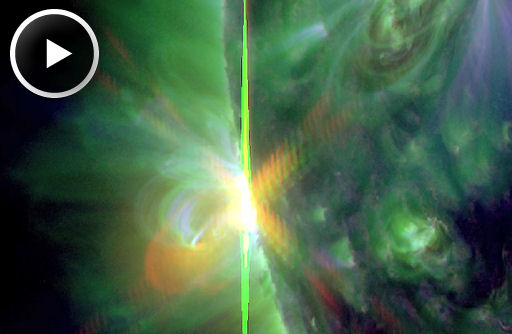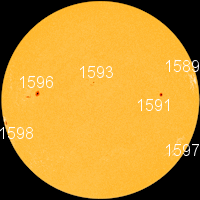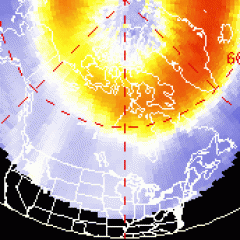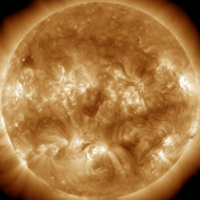ACTIVE SUNSPOT : New sunspot AR1598 is crackling with C- and M-class solar flares. One of the explosions, an M9-flare on Oct. 20th, produced a bright flash of extreme UV radiation recorded by NASA's Solar Dynamics Observatory:
Radiation from the flare sent a wave of ionization rippling through Earth's upper atmosphere, temporarily disturbing the transmission of low-frequency radio signals around Europe and North America. The sunspot has also produced at least one bright CME (movie), but Earth was not in the line of fire.
More flares are in the offing. NOAA forecasters estimate a 60% chance of M-flares and a 5% chance of X-flares during the next 24 hours. Solar flare alerts: text, voice.

![]()
Solar wind
speed: 364.7 km/sec
density: 0.7 protons/cm3
explanation | more data
Updated: Today at 1327 UT
![]()
X-ray Solar Flares
6-hr max: B9 0907 UT Oct22
24-hr: C3 0026 UT Oct22
explanation | more data
Updated: Today at: 1259 UT
![]()
![]()
![]()
Daily Sun: 22 Oct 12
![]()
![]()
New sunspot 1598 poses a threat for M- and X-class solar flares. Credit: SDO/HMI
![]()
![]()
![]()
Sunspot number: 75
What is the sunspot number?
Updated 21 Oct 2012
Spotless Days
Current Stretch: 0 days
2012 total: 0 days (0%)
2011 total: 2 days (<1%)
2010 total: 51 days (14%)
2009 total: 260 days (71%)
Since 2004: 821 days
Typical Solar Min: 486 days
Update 21 Oct 2012
The Radio Sun
10.7 cm flux: 151 sfu
explanation | more data
Updated 21 Oct 2012
![]()
![]()
![]()
Current Auroral Oval:
![]()
Switch to: Europe, USA, New Zealand, Antarctica
Credit: NOAA/POES
![]()
![]()
![]()
Planetary K-index
Now: Kp= 1 quiet
24-hr max: Kp= 1 quiet
explanation | more data
![]()
Interplanetary Mag. Field
Btotal: 4.0 nT
Bz: 0.5 nT north
explanation | more data
Updated: Today at 1327 UT
![]()
![]()
![]()
Coronal Holes: 21 Oct 12
![]()
![]()
There are no large coronal holes on the Earthside of the sun. Credit: SDO/AI





